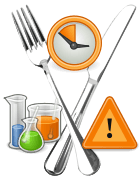“If stochastic mapping was widely used now, perhaps outbreaks, such the recent ones involving salmonella, could be more quickly tracked down and contained”
Uncovering the sources of fresh food contamination could become faster and easier thanks to analysis done at Sandia National Laboratories’ National Infrastructure Simulation and Analysis Center (NISAC).
The study, in the International Journal of Critical Infrastructures, demonstrates how developing a probability map of the food supply network using stochastic network representation might shorten the time it takes to track down contaminated food sources. Stochastic mapping shows what is known about how product flows through the distribution supply chain and provides a means to express all the uncertainties in potential supplier-customer relationships that persist due to incomplete information.
If used on a larger scale, such methods also might assess the vulnerability of food supplies to wide-scale, deliberate contamination.
Tracking down the source of fresh food contamination can be difficult and time-consuming. Sandia analyst Stephen Conrad said difficulties in adequately characterizing connections and product flows among producers, distributors and suppliers can contribute to significant uncertainty in assessing the risk of foodborne illness.
“This is often a serious problem when there is an outbreak of food poisoning in a particular region and the healthcare authorities cannot quickly trace the source of the outbreak,” Conrad said.
When an outbreak occurs, epidemiologists must interview affected people to track down where foodborne exposures happened. Often those interviews take place weeks after the exposure, leading to inaccurate or incomplete information and making it difficult to pinpoint a likely food culprit. Once the tainted food has been identified, investigators must trace up through the food distribution supply chain to locate the source of contamination.
“Epidemiologists involved in trace back start behind the eight ball,” Conrad said. “They attempt to reconstruct the pathway the contaminated food has traveled through the distribution network well after the fact.”
Even at the supply chain level, investigating how food moves through the system is daunting. Conrad said supply chains vary widely from one food marketing system and agricultural sector to another. Some supply chain parts change frequently. Even within a single agricultural sector, some parts may be characterized by enduring supplier/customer relationships, while others may be market-based and highly transitory.
Even industry insiders may not understand the supply chain map. Many only know “one up and one down” — that is, they know only their direct supplier and direct customer. Some information about customers and suppliers can be proprietary and therefore hard to get, Conrad said.
In 2011, sprouts were the focus of a serious E. coli outbreak in Europe, but tracing contaminated products to their source proved difficult.
Sandia researchers applied the stochastic mapping technique to test data from the fresh sprout sector in a single state in the U.S., using a case study of the edible seed sprout distribution system as the basis of their computational model.
“Stochastic network representation provides the ability to incorporate and express the uncertainties using probability maps,” Conrad explained. “The method enables effective risk analysis and designing robust food defense strategies.”
via Sandia National Laboratories
The Latest Streaming News: Food contamination updated minute-by-minute
Bookmark this page and come back often
Latest NEWS
Latest VIDEO








